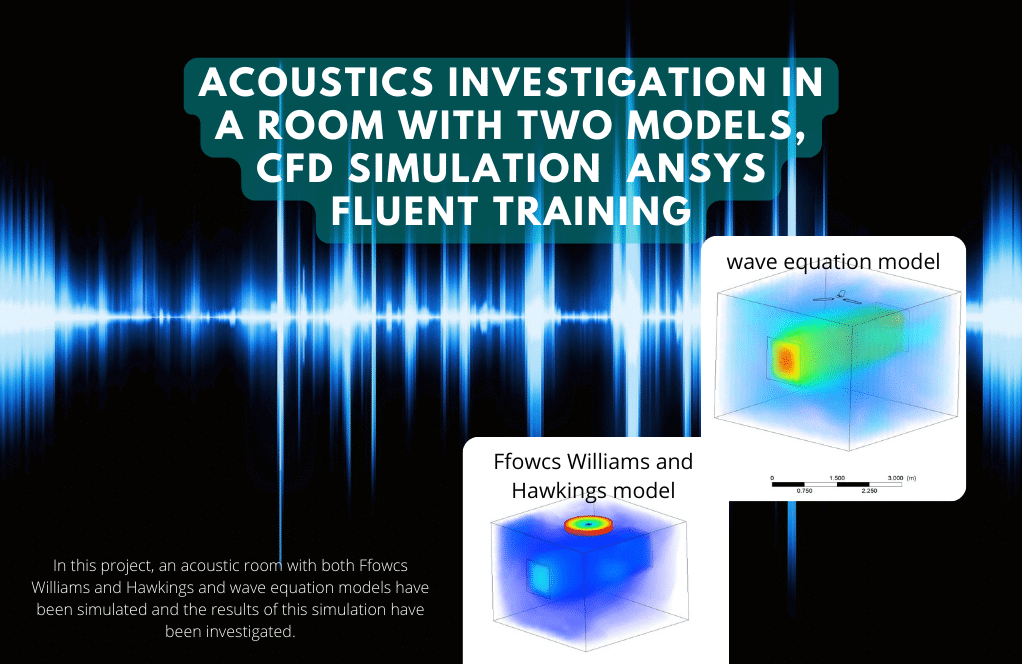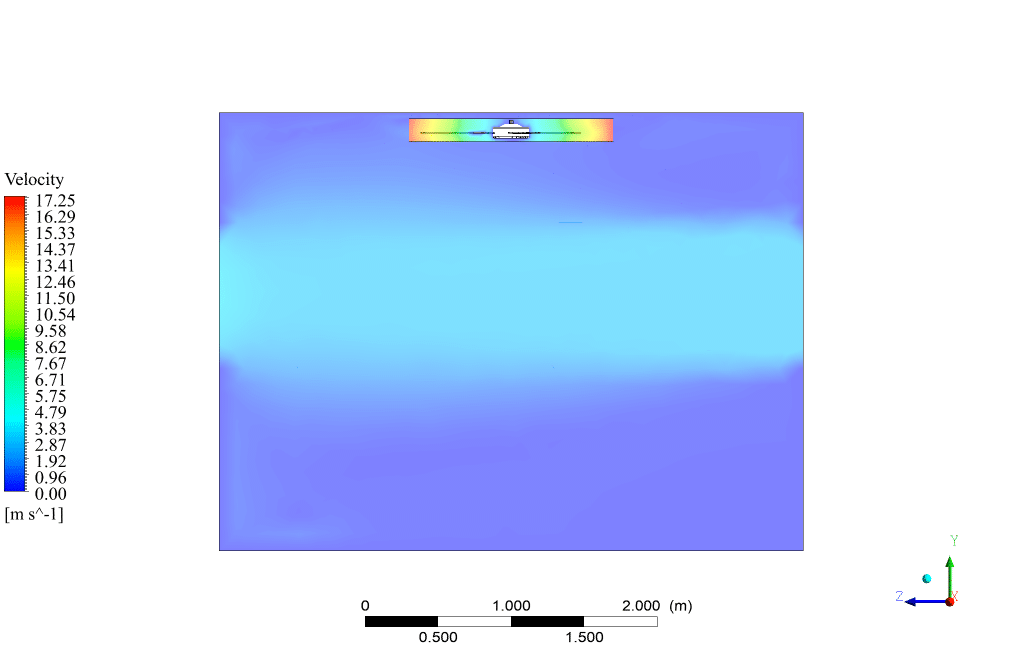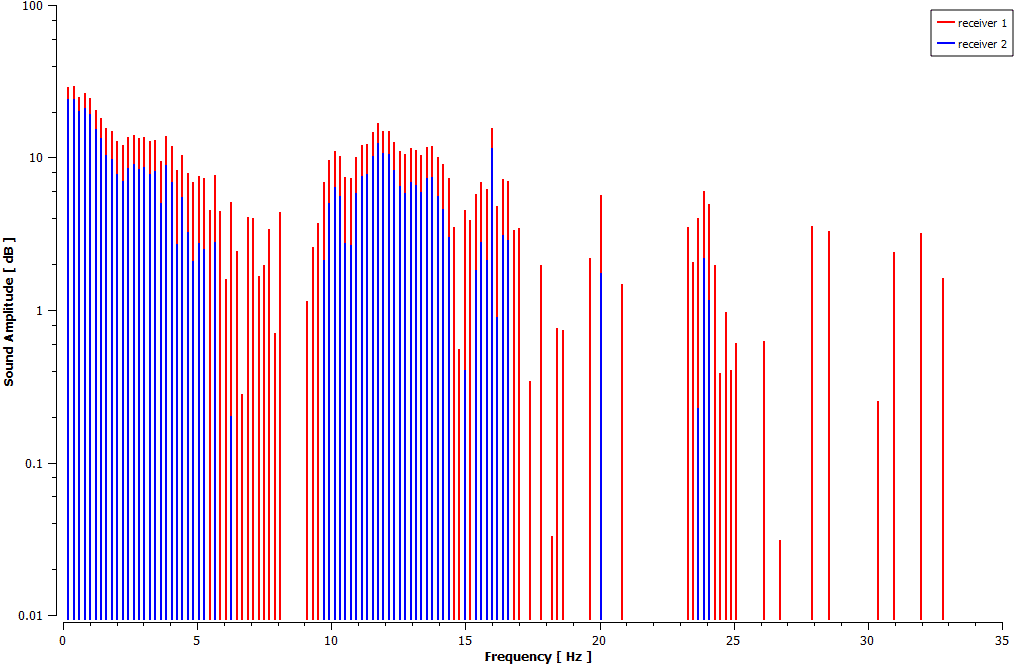Sound Generation of a Ceiling Fan (FW-H Vs. Wave Equation)
$180.00 $90.00 Student Discount
- The problem numerically simulates the Sound Generation of a Ceiling Fan in a Room using ANSYS Fluent software.
- We design the 3-D model by the Design Modeler software.
- We Mesh the model by ANSYS Meshing software, and the element number equals 720783 and 534016.
- We perform this simulation as unsteady (Transient).
- This Project simulates Acoustic with two models, including Ffowcs Williams and Hawkings and Wave equation.
- We use the Mesh Motion method to define the rotational of the fan.
To Order Your Project or benefit from a CFD consultation, contact our experts via email (info@mr-cfd.com), online support tab, or WhatsApp at +44 7443 197273.
There are some Free Products to check our service quality.
If you want the training video in another language instead of English, ask it via info@mr-cfd.com after you buy the product.
Description
Sound Generation of a Ceiling Fan in a Room, FW-H Vs. Wave Equation, Ansys Fluent CFD Simulation Training
In this project, the Sound Generation of a Ceiling Fan in a Room with both Ffowcs Williams and Hawkings and Wave equation models have been simulated. The simulation results have been investigated using ANSYS Fluent software. We perform this CFD project and investigate it by CFD analysis.
Acoustics is a science that deals with the study of mechanical waves in gases, liquids, and solids, including vibration, sound, ultrasound, and infrasound. It concerns production, control, transmission, reception, and sound effects.
The present model is designed in three dimensions using the Design Modeler software. The geometry of the solution is a 3D square shape domain with 4, 3, and 4 m in X, Y, and Z directions, respectively. The ceiling fans center is located at the center of the room and has a 2.7m.
This geometry has meshed in Ansys meshing software, and the total number of cells is 720783 for the first model and 534016 for the second one.
Also, due to the nature of the present problem, the transient solver has been used.
Sound Generation Methodology
This project investigates noise generation due to a ceiling fan in a room. There is a 3d square shape room with a fan in it. Also, two square windows are considered inlets and outlets in which wind blows inside by the incoming velocity of 3 m/s.
The problem is simulated in two ways; at first, the Integral Method by Ffowcs Williams and Hawkings is used in which the fan is rotating by the Mesh Motion method at 240 rpm. Some receiver points at different locations are defined in the domain.
Then in the second step, the ceiling fan is fixed without any motion while the wind blows inside the room with a 3m/s velocity. In this case, the noise generation due to the collision between wind and the fan is examined using a Method Based on the Wave Equation.
Sound Generation Conclusion
At the end of the solution process, two and three-dimensional contours and plots related to room pressure, temperature, and velocity are obtained. CFD Post software draws room sound pressure and amplitude plots in different points defined in Ansys Fluent software.
The temperature and velocity in the room are shown by 3d contour, and parameters related to generated noises are achieved both on the fan walls and the room environment.



















Savanna Mohr –
Does the fan rotation in the simulation accurately represent the noise generation compared to real-life models, or is there a need for calibration?
MR CFD Support –
The fan rotation in the simulation is designed to accurately represent real-life models as much as possible. However, like any simulation, there might be a need for calibration based on specific empirical data to ensure the noise levels predicted are closely aligned with those observed in the physical world.
Deshawn Baumbach –
Does the simulation for the ceiling fan acoustics take into account the materials of the fan and the room or just the airflow dynamics?
MR CFD Support –
In this particular simulation, the primary focus is on the airflow dynamics and subsequent noise generation rather than the materials’ acoustic properties. The CFD analysis covers capturing the airflow disturbances caused by the fan’s motion and the acoustic wave propagation due to these disturbances using the Ffowcs Williams-Hawkings and Wave equation models.
Prof. Luella Doyle DDS –
After the CFD analysis, were there significant differences in the results when comparing the Fan Noise generated using the FW-H method versus the Wave equation? Which one provided more accurate predictions?
MR CFD Support –
Yes, there can be differences in the noise prediction results when comparing simulations using the FW-H method and the Wave equation. Each method deals with acoustics differently, and the FW-H method typically includes more complex analysis of the noise sources and propagation paths. To determine which one provided more accurate predictions, we would validate the results against experimental data or theoretical predictions. Since each method has its own applicability and limitations, the more accurate method would depend on the specific case and the nature of the sound sources and the environment.
Annabelle Schumm –
The tutorial mentions both Ffowcs Williams-Hawkings and the Wave Equation models for simulating the sound generation. Could you provide insights into why different models were used and which one produced more accurate results?
MR CFD Support –
In the tutorial, different models are used to assess their effectiveness in simulating acoustics due to the ceiling fan. The Ffowcs Williams-Hawkings (FW-H) model is suitable for capturing noise generated by moving objects like the rotating fan. In contrast, the Wave Equation model is applied to investigate the stationary noise sources, such as the interaction between the stationary fan and air flow. Accuracy will depend on the specific aspects of noise you’re measuring; the FW-H is typically more accurate for moving source noise predictions, while the Wave Equation model can be advantageous for simpler cases with stationary sources.
Delmer Schowalter Sr. –
What are the key differences in results when using the Integral Method by Ffowcs Williams and Hawkings compared to the Method Based on the Wave Equation?
MR CFD Support –
The main differences in results between the two methods primarily lie in the way they predict and compute the noise generation and propagation. The Integral Method by Ffowcs Williams and Hawkings (FW-H) takes into account the moving fan and its mesh motion to simulate actual fan rotation, providing detailed noise generation data related to rotating parts. On the other hand, the Wave Equation method focuses on noise generation due to interaction between the wind and the stationary fan, which might result in less complex but faster computations of the acoustic field. Therefore, aspects like the directivity of the sound, the propagation pattern, and the frequency content of the generated noise may differ between the two methods.
Jayda Heidenreich Sr. –
I’m wondering if the mesh motion method for rotating the fan could affect the accuracy of the sound measurements in comparison to a model with a stationary fan and wind effects. Could you elaborate on that?
MR CFD Support –
When we compare the Ffowcs Williams and Hawkings (FW-H) method where the ceiling fan is rotating to the Wave Equation method with a stationary fan, differences in accuracy can occur. The FW-H method captures noise generated from the moving fan which can result in more accurate prediction of sound generated by fan rotation and interactions with airflow. Conversely, the Wave Equation method might be more representative of noise from stationary objects in airflow. The mesh motion captures more dynamic interactions, potentially leading to a difference in acoustic results.
Lance Lindgren –
I really appreciated the detailed explanation on the methodologies used for investigating noise generation in the simulation course. It was interesting to learn how both the Integral Method and Method Based on the Wave Equation can be utilized.
MR CFD Support –
Thank you for your positive feedback! We’re thrilled to hear you found the methodologies for investigating noise generation informative and helpful. Understanding both the Integral Method by Ffowcs Williams and Hawkings, as well as the Wave Equation method, is crucial in acoustic simulations. If you have more questions or need further clarification on these topics, feel free to reach out. Happy simulating!
Shaniya Padberg IV –
This training helped me understand how sound behaves differently in various simulated environments. The analysis of both models offered a comprehensive comparison. Does the training provide recommendations for which model is most appropriate under different circumstances?
MR CFD Support –
The training aims to show the applicability and characteristics of each acoustic modeling approach. Based on the simulation, guidelines can be provided on choosing between the FW-H and the Wave Equation models depending on factors such as the level of detail required, computational resources, and the specific goals of your acoustic analysis.
Mr. Grady Gulgowski II –
I am very interested to know at which points in the room were the sounds levels measured and also how did the location affect the sound level?
MR CFD Support –
The sound levels were measured at predefined receiver points situated at different locations in the room to capture the spatial variation of the noise generated by the ceiling fan. These points were strategically placed to assess the acoustic impact at various distances and angles relative to the fan. Differing locations show various sound levels due to the propagation and attenuation effects. Locations closer to the fan tend to have higher sound pressure levels, while those farther away or behind obstacles might experience reduced levels due to absorption and scattering.
Brielle McClure –
This training, which explains both approaches for simulating the sound generation of a ceiling fan, seems perfect for understanding practical acoustics in CFD. Great job!
MR CFD Support –
Thank you for your kind words! We’re delighted to know the training provided you with a practical understanding of acoustics in computational fluid dynamics. If you have any further questions or need assistance, please feel free to reach out!
Ms. Nelle Cronin –
I’ve noticed there’s a method based on the wave equation to predict the sound generation of a ceiling fan. Can you explain what the wave equation method involves and how it is different from the FW-H method used in this simulation?
MR CFD Support –
In this simuation, the wave equation method is used to predict the sound generated by the fan in a quiescent room. This method is a numerical approximation of the actual wave equation that predicts how sound pressure waves propagate in the environment. Unlike the FW-H method, which considers the aerodynamic sound emitted and propagated from the fan blades and is based on an integral method, the wave equation method looks specifically at sound generation due to the wind and the stationary fan. The wave equation accounts for the fan’s presence and shape as the wind interacts with it,-but the fan does not rotate in this method. The sound is predicted as a result of the wind’s interaction with static objects within the room.
Blanca Purdy –
Is it possible to compare the results of noise levels obtained through the Ffowcs Williams and Hawkings method with those obtained from the Wave Equation method?
MR CFD Support –
Yes, comparison between the noise levels obtained from the Ffowcs Williams and Hawkings method and the Wave Equation method is one of the key aspects this simulation focuses on. It provides insights into the effectiveness of each method in predicting noise generated by the ceiling fan.